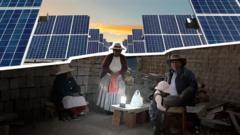---
In the quiet village of Pampa Clemesí, the sight of the Rubí solar power plant, just a stone’s throw away, brings both hope and frustration. While the facility powers approximately 351,000 homes, its immediate neighbors are still in darkness. Rosa Chamami and her fellow villagers, numbering around 150, rely on solar torches or battery donations, but lack full access to electricity that the solar panels provide.
Installed between 2018 to 2024, the solar complexes in Peru’s Moquegua region shine brightly during the day. Yet at night, Pampa Clemesí is enveloped in darkness, illustrating a stark paradox. Experts like Carlos Gordillo suggest that the focus on profitability has left rural residents like Rosa disconnected from vital energy services.
Orygen, the company behind Rubí, claims they have set up the infrastructure to connect the village, including the installation of over 53 power towers. However, the final connection to homes is waiting on the government, which has delayed wiring work scheduled for 2025.
Amid these hardships, simple daily activities become challenges. Rosa struggles to charge her phone, while fellow villager Rubén Pongo, who manages a fridge powered by his own purchased solar system, provides what little support he can to the community.
Pampa Clemesí's journey began in the early 2000s, built mainly from scraps sourced from the nearby solar panels. Basic amenities are scarce, leading to a dwindling population and diminishing hopes for a better future. Residents often cook with firewood or gas, often risking health issues due to lack of safe cooking options.
As dusk falls with no lights to illuminate their homes, residents gather to share meals in darkness, whispering prayers for daily needs while looking to the sun, their only reliable source of hope. “Here, we always have the sun,” says Rosa, embodying the spirit of resilience in the face of neglect.
In the quiet village of Pampa Clemesí, the sight of the Rubí solar power plant, just a stone’s throw away, brings both hope and frustration. While the facility powers approximately 351,000 homes, its immediate neighbors are still in darkness. Rosa Chamami and her fellow villagers, numbering around 150, rely on solar torches or battery donations, but lack full access to electricity that the solar panels provide.
Installed between 2018 to 2024, the solar complexes in Peru’s Moquegua region shine brightly during the day. Yet at night, Pampa Clemesí is enveloped in darkness, illustrating a stark paradox. Experts like Carlos Gordillo suggest that the focus on profitability has left rural residents like Rosa disconnected from vital energy services.
Orygen, the company behind Rubí, claims they have set up the infrastructure to connect the village, including the installation of over 53 power towers. However, the final connection to homes is waiting on the government, which has delayed wiring work scheduled for 2025.
Amid these hardships, simple daily activities become challenges. Rosa struggles to charge her phone, while fellow villager Rubén Pongo, who manages a fridge powered by his own purchased solar system, provides what little support he can to the community.
Pampa Clemesí's journey began in the early 2000s, built mainly from scraps sourced from the nearby solar panels. Basic amenities are scarce, leading to a dwindling population and diminishing hopes for a better future. Residents often cook with firewood or gas, often risking health issues due to lack of safe cooking options.
As dusk falls with no lights to illuminate their homes, residents gather to share meals in darkness, whispering prayers for daily needs while looking to the sun, their only reliable source of hope. “Here, we always have the sun,” says Rosa, embodying the spirit of resilience in the face of neglect.


















